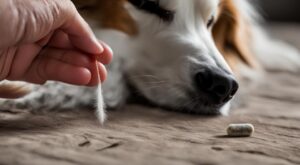Labrador Retrievers are one of the most popular dog breeds in the world for many reasons. They are known for their friendly and outgoing nature, loyalty, and intelligence. If you are considering adding a Labrador to your family, it’s essential to understand their unique characteristics and traits.
In this article, we will explore some interesting facts about Labrador Retrievers, including their origin, temperament, care requirements, and their compatibility with other pets. We will also discuss famous Labradors, training techniques, and their relationship with children.
Key Takeaways:
- Labrador Retrievers are one of the most popular dog breeds in the world
- Labradors are known for their friendly and outgoing nature, loyalty, and intelligence
- This article will explore interesting facts about the breed, including their origin, temperament, and care requirements
- We also discuss famous Labradors, training techniques, and their relationship with children and other pets
- If you are considering adding a Labrador to your family, this article will provide you with valuable information to make an informed decision
Origin of the Labrador
The Labrador Retriever, commonly called the Labrador, is one of the most popular and loved dog breeds in the world. But where do they come from? The answer can be found in its origin, which dates back to the island of Newfoundland, in Canada.
At the beginning of the 19th century, the island’s inhabitants bred a type of dog known as the St. John’s water dog, used to assist in fishing tasks. Over time, these dogs were crossed with English retrievers, brought by British fishermen.
It was only at the end of the 19th century that the name “Labrador Retriever” was given to the breed, in honor of the Labrador region, although the real origin is on the island of Newfoundland.
“The Labrador Retriever was originally bred to assist fishermen in catching fish, but today it is one of the most versatile dog breeds in existence, working as a guide for the visually impaired, police dogs and therapists in hospitals and clinics.”
Characteristics of the Labrador Retriever
| Height | Weight | Life expectancy |
|---|---|---|
| between 54 and 57 cm (males) | between 27 and 34 kg (males) | between 10 and 12 years old |
| between 52 and 56 cm (females) | between 25 and 32 kg (females) |
The Labrador Retriever has a dense, waterproof coat, which can be black, yellow or chocolate. They are strong, muscular, friendly dogs with a short, bushy tail, sometimes described as resembling an otter’s tail.
Labradors are intelligent and adaptable animals, and one of their most notable characteristics is their love of water. They love swimming and retrieving objects, which means they enjoy fetch games and throwing games. Their gentle and friendly temperament makes them one of the most popular dog breeds for families and children.
Labrador characteristics
The Labrador Retriever is a medium to large dog, with a height of 54 to 61 cm for males and 51 to 56 cm for females. They are strong, muscular dogs, with an athletic appearance that reflects their energetic and hard-working nature.
One of the Labrador’s most distinctive features is its otter-like tail, which is wide at the base and gradually tapers toward the tip. This feature helps the dog swim, balancing the body and acting as a rudder to change direction in the water.
The Labrador has a thick, water-resistant double coat with a short, dense outer coat and a soft, thick inner coat. The most common color of this breed is yellow, black or chocolate.
Labradors are known for having a friendly and gentle personality. They are considered one of the most intelligent and easiest dogs to train, helping them become popular pets among people of all ages.
Another notable feature of the Labrador is its strong jaw and soft mouth. This means they can hold objects firmly without damaging them.
Popular Dog Size Comparison
| dog breed | Height (cm) | Weight (kg) |
|---|---|---|
| Labrador Retriever | 54-61 (males); 51-56 (females) | 29-36 |
| Golden Retriever | 56-61 (males); 51-56 (females) | 27-34 |
| English bulldog | 30-40 | 25-30 |
| Standard Poodle | 38-61 (males and females) | 20-32 |
When choosing a dog, size is an important factor to consider. As shown in the table above, the Labrador Retriever is a little taller and heavier on average compared to other popular breeds such as the Golden Retriever and the English Bulldog. However, he is relatively smaller than other dogs like the Standard Poodle.
Labrador Temperament
The Labrador Retriever is known for its friendly and sociable temperament. They are extremely loyal, affectionate and gentle animals, with a calm and trustworthy personality that makes them excellent companions for families and children.
Labradors also have a keen intelligence and a willingness to please, which makes them versatile in a variety of roles, from therapy and search and rescue dogs to guide and assistance dogs.
Although their temperament is generally quite uniform, each Labrador has its own unique personality and characteristics, and it is important to dedicate adequate time to getting to know and socialize your pet so that it can develop into a well-behaved and happy dog.

“The Labrador is a constant friend, a loyal companion and a tireless worker”
Labrador care
Labradors are active and strong dogs, and require special care to keep them happy and healthy. Here are some tips to ensure your Labrador is fit and happy:
Exercise
Labrador dogs are exceptionally active and need a lot of exercise. They enjoy walking, running, swimming and playing and need at least an hour of physical activity daily. Additionally, it is essential to allow your Labrador plenty of space to move around.
Grooming
Labradors have dense, waterproof coats that need to be brushed regularly. As their fur is prone to tangling, an occasional bath is also necessary to prevent them from becoming dirty and smelly. Furthermore, cleaning your ears and teeth is essential to prevent infections and oral diseases.
Nutrition
Your Labrador’s diet should include foods rich in protein, vitamins and minerals. Food should be divided into two or three servings daily, depending on the dog’s age and activity level. However, it is important to avoid overeating and keep your Labrador at a healthy weight to prevent health problems such as obesity and joint problems.
Veterinary care
Regular vet visits are an important part of caring for your Labrador. They need vaccines and preventive exams to keep their health up to date. Your veterinarian can also advise you on how to prevent or treat common health problems in Labradors, such as hip dysplasia and skin problems.
“To ensure your Labrador’s happiness and health, be sure to provide plenty of exercise, a balanced diet, regular grooming and regular veterinary appointments.”
Curiosities about Labrador dogs
Labrador Retrievers are a breed of dog with a distinct personality and many interesting facts. One of its most notable abilities is its excellent sense of smell.
Labrador Retrievers are widely used in search and rescue work, as well as in police operations, thanks to their incredible ability to detect specific odors, even in difficult conditions or over large areas.
On average, a Labrador dog has around 220 million sensory cells in their nose, making them some of the best sniffers in the world. Additionally, their friendly and dependent nature makes them also excellent gift companions for anyone who loves animals, especially families with children.
Characteristics of dogs’ sense of smell
| Type of dog | Number of olfactory cells | Number of olfactory receptors |
|---|---|---|
| Bulldog | 123 million | 500 |
| Beagle | 225 million | 700 |
| Labrador Retrievers | 220 million | 600 |
| Bloodhound | 300 million | 1600 |
“A dog’s sense of smell is truly one of nature’s greatest wonders. They can follow a specific scent in a world full of odors and even detect chemical changes that almost no electronic equipment could identify.” – Leslie C. Aiello, archaeologist and evolutionary biologist
Labrador Retrievers are also very active and love exercise as well as swimming in aquatic environments. They have a dense, water-resistant coat that keeps them dry and warm even in adverse conditions. These characteristics are just a few of the many reasons why Labrador Retrievers are one of the most popular dog breeds across the world.
Labrador Retriever Curiosities
Labrador Retrievers are known for their friendly and outgoing nature, but did you know that they were initially bred to assist fishermen in catching fish? This breed’s unique qualities contribute to its popularity as a family pet, and here are some interesting facts that you may not have known:
- Labrador Retrievers have a love for water: Due to their history as working dogs, Labradors have a natural affinity for water. Their webbed toes and Otter-like tails make them excellent swimmers!
- Labrador Retrievers are great problem solvers: This intelligent breed is known to have excellent problem-solving abilities and is often used as a service dog for people with disabilities.
- Labrador Retrievers have an exceptional sense of smell: Known for their remarkable sense of smell, it has been estimated that Labrador Retrievers have over 200 million olfactory receptors, making them excellent sniffer dogs!
- Labrador Retrievers are always hungry: Labradors are known to have a voracious appetite and should be fed balanced meals to avoid overeating and health problems that may follow.
To sum up, the Labrador Retriever is a fascinating breed that has many unique qualities and is beloved by many. Curiosidades Labrador Retriever showcase the breed’s incredible intelligence, problem-solving abilities, and love for water that makes them an exceptional family pet.
Famous Labradors
Labrador Retrievers have become famous beyond their role as a beloved family pet. Many Labradors have made a name for themselves in various fields. Here are some of the most famous Labradors:
| Name | Claim to Fame |
|---|---|
| Tucker | Starred as a therapy dog in the TV show “Fuller House” |
| Own | Assisted his disabled owner, Allen Parton, by performing tasks such as inserting ATM cards, paying cashiers, and even detecting PTSD seizures. This earned him the PDSA’s Gold Medal, the highest honor for animal bravery and exceptional service. |
| Buddy | Bill Clinton’s beloved Labrador Retriever, who even had his own book, “First Dog: A Memoir by the First Dog”. |
| Marley | The star of the bestselling novel and film, “Marley & Me”, based on the true story of author John Grogan and his mischievous Labrador Retriever. |
These are just a few examples of the incredible stories of famous Labrador Retrievers. It’s no surprise that Labradors continue to capture the hearts of many, from celebrities to everyday people.
Labrador training
Labrador Retrievers are intelligent dogs and eager to please their owners, making them easy to train. It is essential to start training early to establish clear and consistent communication with your Labrador. Here are some tips for successfully training your Labrador:
1. Use a positive approach
Train your Labrador based on positive reinforcement. Use praise and treats to reward desired behaviors and avoid punishment or violence. Be patient and consistent in your training and celebrate each success.
2. Focus on socialization
Invest time and effort into socializing your Labrador from an early age. Expose him to different situations, people and other pets to help him develop social skills and appropriate behaviors.
3. Involve the whole family
Maintain constant training and involve the whole family to ensure consistency in rules and commands. Make sure everyone knows the key words, like “sit” and “stay.”
4. Set clear limits
Set clear limits from the beginning and use firm, consistent commands to help teach your Labrador which behaviors are appropriate and which should be avoided.
5. Train with the clicker method
The clicker method is an efficient and popular way to train Labradors. It is based on the use of a sound click to indicate when a desired behavior is performed so that the pet associates this sound with the associated reward.
“A dog needs a strong and consistent leader, but that doesn’t mean being harsh or cruel. Be fair and reward your dog whenever you can.”
Labradors and children
Labrador Retrievers have long been a popular choice for families with children, as their friendly and gentle nature makes them well-suited for households with kids. They are known for their patience and playfulness, and they often form close bonds with children, becoming loyal and protective companions.
However, it is essential to take proper precautions when introducing Labradors to children to ensure a safe and positive experience. Parents should always supervise interactions between kids and dogs and teach children how to interact with dogs safely.
Teaching children to avoid approaching dogs while they are sleeping, eating, or playing with toys is crucial, as these situations can sometimes lead to aggression or territorial behavior. It is also important to teach children to approach dogs calmly and avoid sudden movements that may startle or scare them.
It is also recommended to socialize Labradors with children of all ages from a young age to ensure they are comfortable and well-adjusted around kids. This process involves slowly and gradually introducing the dog to children and rewarding them for good behavior.
In summary, Labradors and children can make fantastic companions when introduced and supervised correctly. Parents should teach children how to interact with dogs safely and socialize their dogs with kids from a young age to ensure a positive and safe experience.

Labradors and other pets
Labrador Retrievers are known for their friendly and outgoing nature, which extends to other pets in the household. With proper socialization and training, Labradors can get along well with other animals, including cats, rabbits, and birds.
When introducing a new pet to your Labrador, it is important to take things slow and supervise the interactions closely. Allow them to sniff and explore each other in a controlled environment, such as a fenced-in backyard or a separate room with a baby gate. Reward positive behavior with treats and praise.
It is also crucial to establish boundaries and hierarchies between your pets, ensuring that your Labrador knows its place in the household. Use positive reinforcement training to reinforce good behavior and discourage any negative behavior, such as chasing or aggression towards other animals.
Finally, be mindful of your pets’ individual personalities and preferences, as some may be more compatible with Labradors than others. Always prioritize the safety and well-being of all animals involved.
Comparing Labrador Retrievers and other popular pets
| Labrador Retriever | Golden Retriever | German Shepherd | |
|---|---|---|---|
| Weight (lbs) | 55-80 | 55-75 | 50-90 |
| Life Span (years) | 10-12 | 10-12 | 9-13 |
| Compatibility with other pets | High | High | Moderate |
| Exercise Needs (hours per day) | 1-2 | 1-2 | 1-2 |
| Trainability | High | High | High |
Conclusion
Labrador Retrievers are truly remarkable dogs, known for their friendly and outgoing nature, their intelligence, and their loyalty. They make excellent family pets and are well-suited to individuals who are looking for a companion that can keep up with their active lifestyle. Whether you have a family with children, other pets, or just want a furry friend to keep you company, a Labrador Retriever may be the perfect addition to your household.
From their fascinating history and distinctive physical characteristics to their exceptional sense of smell and eagerness to please, Labrador Retrievers have a lot to offer. By understanding their care requirements, training techniques, and compatibility with other pets and children, you can ensure a harmonious home environment and a rewarding relationship with your furry friend.
So if you’re considering adding a new member to your family, consider a Labrador Retriever – you won’t be disappointed!
FAQ
What are some interesting facts about Labrador Retrievers?
Labrador Retrievers are known for their friendly and outgoing nature. They are also highly intelligent and excel in various roles such as search and rescue, therapy work, and assistance tasks for people with disabilities.
What is the origin of the Labrador Retriever?
The Labrador Retriever originated in Newfoundland, Canada. They were initially bred by fishermen to assist in retrieving fish and pull nets from the icy waters. Their webbed feet and water-resistant coat make them excellent swimmers and retrievers.
What are the physical characteristics of Labrador Retrievers?
Labrador Retrievers have a sturdy build with a broad head and expressive eyes. They possess a thick double coat, with the outer layer being water-resistant. Their otter-like tail is thick at the base and tapers towards the end, providing balance and serving as a rudder while swimming.
What is the temperament of Labrador Retrievers?
Labrador Retrievers are known for their friendly and gentle temperament. They are highly social dogs and get along well with both humans and other animals. They are loyal, intelligent, and eager to please, which makes them trainable and suitable for various tasks and roles.
What are the essential care requirements for Labrador Retrievers?
Labrador Retrievers require regular exercise to keep them physically and mentally stimulated. They should be groomed regularly to maintain their coat’s health, and their diet should consist of high-quality dog food based on their age, size, and activity level.
What are some interesting facts about Labrador Retrievers as a breed?
Labrador Retrievers have an exceptional sense of smell, making them highly efficient in scent detection tasks such as search and rescue or drug detection. They are also known for their friendly and patient nature, which contributes to their popularity as therapy dogs.
What are some captivating trivia about Labrador Retrievers?
Labrador Retrievers have a gentle mouth and are known for their “soft mouth” retrieving skills. They can carry delicate objects without damaging them. Additionally, they have been recognized as the most popular breed in the United States for several years.
Are there any famous Labrador Retrievers?
Yes, several Labrador Retrievers have gained fame for their remarkable contributions. Examples include Endal, a service dog who received numerous awards for his assistance to disabled veteran Allen Parton, and Marley, the lovable and mischievous Labrador from the book and movie “Marley & Me”.
What is the training approach for Labrador Retrievers?
Labrador Retrievers are intelligent and eager to please, making them highly trainable. Positive reinforcement techniques, such as rewards and praise, work well with this breed. Consistency, patience, and early socialization are important for shaping their behavior.
How do Labrador Retrievers interact with children?
Labrador Retrievers typically have a natural affinity for children. They are patient, gentle, and often protective of them. However, proper supervision and teaching children how to interact with dogs are essential to ensure a safe and harmonious relationship.
Can Labrador Retrievers get along with other pets?
Labrador Retrievers generally get along well with other pets, including cats and other dogs, especially when properly introduced. Early socialization and supervision during initial interactions are key to fostering a positive relationship between Labrador Retrievers and other animals.




